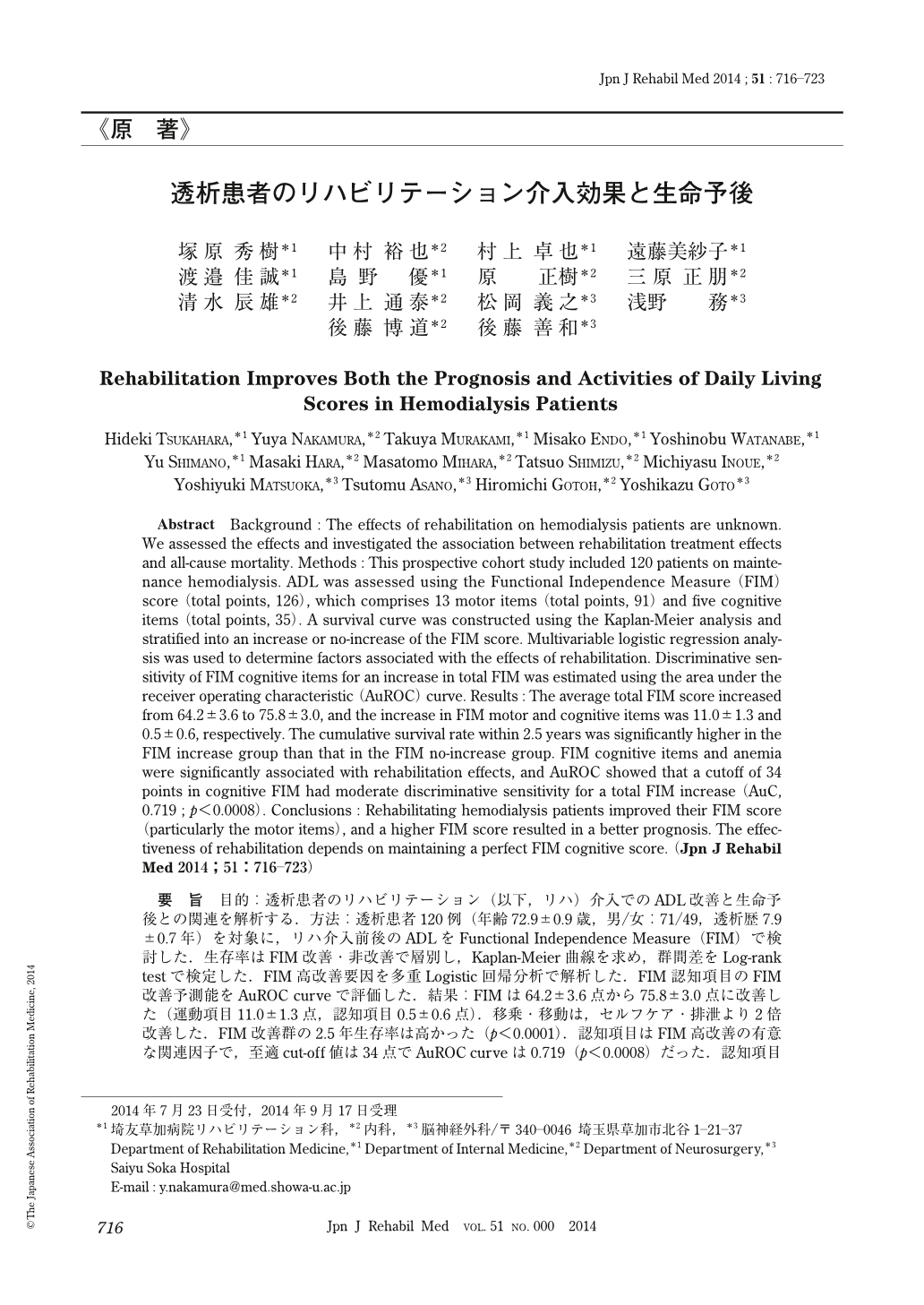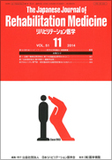Japanese
English
- 販売していません
- Abstract 文献概要
- 1ページ目 Look Inside
- 参考文献 Reference
要旨 目的:透析患者のリハビリテーション(以下,リハ)介入でのADL改善と生命予後との関連を解析する.方法:透析患者120例(年齢72.9±0.9歳,男/女:71/49,透析歴7.9±0.7年)を対象に,リハ介入前後のADLをFunctional Independence Measure(FIM)で検討した.生存率はFIM改善・非改善で層別し,Kaplan-Meier曲線を求め,群間差をLog-rank testで検定した.FIM高改善要因を多重Logistic回帰分析で解析した.FIM認知項目のFIM改善予測能をAuROC curveで評価した.結果:FIMは64.2±3.6点から75.8±3.0点に改善した(運動項目11.0±1.3点,認知項目0.5±0.6点).移乗・移動は,セルフケア・排泄より2倍改善した.FIM改善群の2.5年生存率は高かった(p<0.0001).認知項目はFIM高改善の有意な関連因子で,至適cut-off値は34点でAuROC curveは0.719(p<0.0008)だった.認知項目満点患者のFIM改善値は14.9点で,34点以下患者より2.6倍改善した.結論:透析患者のリハ介入で運動機能の改善は大きく,FIM改善患者の生命予後は良い.ADL改善にはFIM認知項目35点満点の保持が重要である.
Abstract Background : The effects of rehabilitation on hemodialysis patients are unknown. We assessed the effects and investigated the association between rehabilitation treatment effects and all-cause mortality. Methods : This prospective cohort study included 120 patients on maintenance hemodialysis. ADL was assessed using the Functional Independence Measure (FIM) score (total points, 126), which comprises 13 motor items (total points, 91) and five cognitive items (total points, 35). A survival curve was constructed using the Kaplan-Meier analysis and stratified into an increase or no-increase of the FIM score. Multivariable logistic regression analysis was used to determine factors associated with the effects of rehabilitation. Discriminative sensitivity of FIM cognitive items for an increase in total FIM was estimated using the area under the receiver operating characteristic (AuROC) curve. Results : The average total FIM score increased from 64.2±3.6 to 75.8±3.0, and the increase in FIM motor and cognitive items was 11.0±1.3 and 0.5±0.6, respectively. The cumulative survival rate within 2.5 years was significantly higher in the FIM increase group than that in the FIM no-increase group. FIM cognitive items and anemia were significantly associated with rehabilitation effects, and AuROC showed that a cutoff of 34 points in cognitive FIM had moderate discriminative sensitivity for a total FIM increase (AuC, 0.719 ; p<0.0008). Conclusions : Rehabilitating hemodialysis patients improved their FIM score (particularly the motor items), and a higher FIM score resulted in a better prognosis. The effectiveness of rehabilitation depends on maintaining a perfect FIM cognitive score.

Copyright © 2014, The Japanese Association of Rehabilitation Medicine. All rights reserved.


